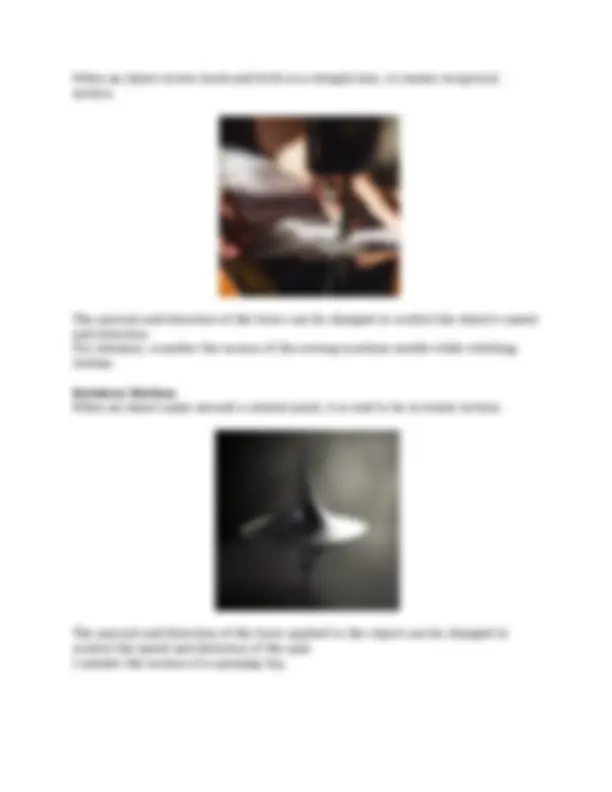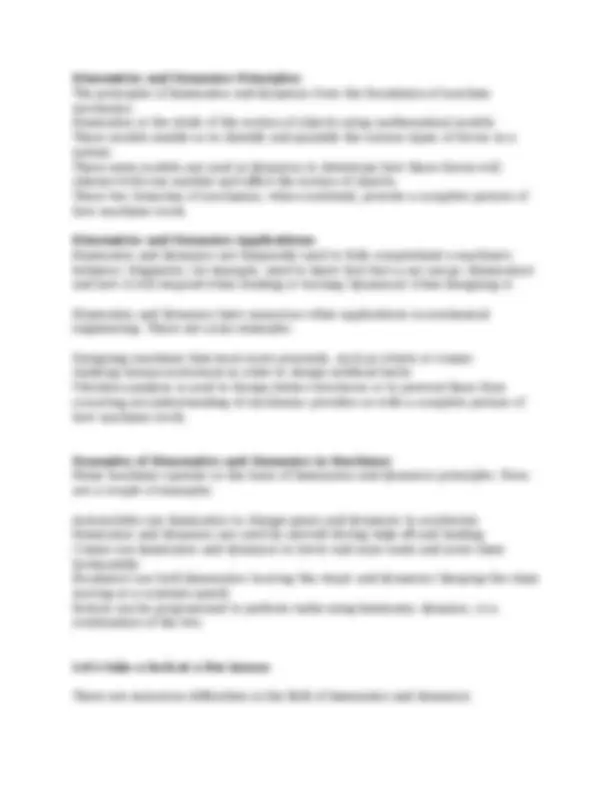





Study with the several resources on Docsity

Earn points by helping other students or get them with a premium plan


Prepare for your exams
Study with the several resources on Docsity

Earn points to download
Earn points by helping other students or get them with a premium plan
Community
Ask the community for help and clear up your study doubts
Discover the best universities in your country according to Docsity users
Free resources
Download our free guides on studying techniques, anxiety management strategies, and thesis advice from Docsity tutors
A detailed breakdown of Kinematics and Dynamics in Mechanics. Kinematics refers to the study of motion without regard for the cause, while Dynamics is the study of the causes of motion. the difference between Kinematics and Dynamics, and how they are frequently studied together for a complete understanding of a machine's behavior. It also discusses the four types of basic machine movements: linear, circular, reciprocal, and rotatory.
Typology: Summaries
1 / 5

This page cannot be seen from the preview
Don't miss anything!




Detailed breakdown of Kinematics & Dynamics Kinematics & Dynamics Kinematics: Kinematics is a term that refers to motion. The study of motion without regard for the cause is known as kinematics. It basically means looking at how things move rather than why they move. It investigates how values such as distance or displacement, speed or velocity, and acceleration change over time.And It is frequently described as applied geometry, in which the movement of a mechanical system is described using rigid Euclidean transformations. Points in a plane's coordinates are two-dimensional vectors in R (two-dimensional space). Dynamics: Dynamics, on the other hand, is the study of the causes of motion. The branch of mechanics that deals with the movement of objects and the forces that drive that movement is known as dynamics. You will most likely study dynamics in a physics class. The principles of dynamics govern car movement, or lack thereof. A car moving despite the forces of multiple objects attempting to stop it is an example of dynamics. Because the car has a large mass, its momentum will increase if it is not stopped. What is the difference between Kinematics and Dynamics? Kinematics is the study of the motion of objects without regard for the forces that cause the motion in mechanics. The study of how forces affect the motion of objects is known as dynamics. Kinematics can be used to predict how a machine will behave under specific conditions. Dynamics can be used to calculate the forces required to generate a given amount of movement. Kinematics, on the other hand, is concerned with describing motion, whereas dynamics is concerned with explaining why motion occurs. Kinematics and dynamics are frequently studied together because they are both required for a complete understanding of a machine's behavior.
There are four types of basic machine movements: linear, circular, reciprocal, and rotatory.
Linear motion: Linear motion is the most common type of movement for machines ● It is created when a force is applied to an object in a straight line ● The speed and direction of the object can be controlled by changing the amount or direction of the force ● For example, a train moving along a straight line. Circular motion: Circular motion is the movement of an object in a circle or oval path. The object's speed and direction can be controlled by changing the radius of the circle or oval or the speed at which it moves around the circle or oval. Planets, for example, revolve around the sun. reciprocal motion:
Kinematics and Dynamics Principles: The principles of kinematics and dynamics form the foundation of machine mechanics. Kinematics is the study of the motion of objects using mathematical models. These models enable us to identify and quantify the various types of forces in a system. These same models are used in dynamics to determine how these forces will interact with one another and affect the motion of objects. These two branches of mechanics, when combined, provide a complete picture of how machines work. Kinematics and Dynamics Applications: Kinematics and dynamics are frequently used to fully comprehend a machine's behavior. Engineers, for example, need to know how fast a car can go (kinematics) and how it will respond when braking or turning (dynamics) when designing it. Kinematics and dynamics have numerous other applications in mechanical engineering. These are some examples: Designing machines that must move precisely, such as robots or cranes studying human movement in order to design artificial limbs Vibration analysis is used to design better structures or to prevent them from occurring.An understanding of mechanics provides us with a complete picture of how machines work. Examples of Kinematics and Dynamics in Machines: Many machines operate on the basis of kinematics and dynamics principles. Here are a couple of examples: Automobiles use kinematics to change gears and dynamics to accelerate. Kinematics and dynamics are used by aircraft during take-off and landing. Cranes use kinematics and dynamics to lower and raise loads and move them horizontally. Escalators use both kinematics (moving the steps) and dynamics (keeping the steps moving at a constant speed). Robots can be programmed to perform tasks using kinematic, dynamic, or a combination of the two. Let's take a look at a few issues: There are numerous difficulties in the field of kinematics and dynamics.
The development of accurate mathematical models of physical systems is one challenge. Another challenge is to create efficient algorithms for kinematics and dynamics problems. Another challenge is to create new methods for analyzing and comprehending physical system behavior. Conclusion: You can use a better understanding of kinematics and dynamics to solve various engineering problems or design more efficient mechanisms. Skill-Lync provides a variety of resources to help you learn more about Kinematics and Dynamics, such as video lessons, quizzes, and articles. We provide courses in mechanical engineering concepts such as CAD, CAE, MATLAB design, FEA, Hypermesh, LS-DYNA for structural mechanics, and so on.